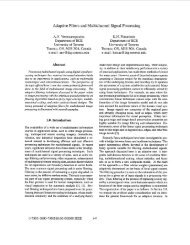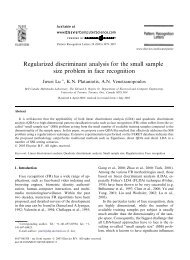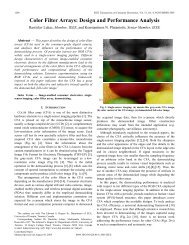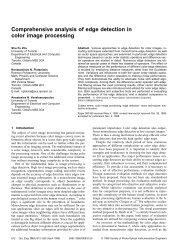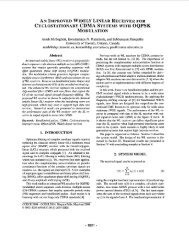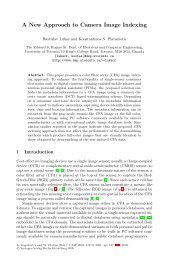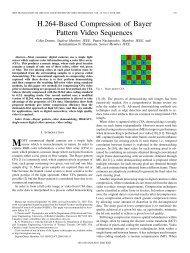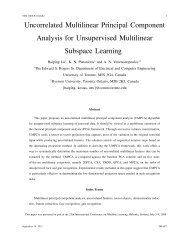For the evaluation of the impact of capturing conditionvariations to the performance of the gait recognition system,we report detailed results on the USF database. As seen inTable 4, the performance of the gait recognition system is satisfactorywhen there are changes in shoe or/and viewpoint.However, in cases of excessive viewpoint differences betweenreference and test sequences, the distortions on the extractedfeature vectors would be considerable and, unavoidably, thiswould have a detrimental effect on recognition performance.Clearly, the performance of most tested algorithms sufferswhen a change in surface is involved. This is an important conclusion,and it imposes some limitations on the capturingprocess appropriate for a gait recognition system, i.e., surfacevariations should be avoided. The complete cumulative matchscores are displayed in Figure 9. As seen, in most cases, thecorrect subject was with high confidence in the top ten matches(out of a total of 71 subjects in the reference database). Thisprovides a strong indication that, even if gait is currently notable to achieve reliable exact recognition, it can be readily usedin a multibiometric system as an efficient filter prior to theutilization of some other biometric.SUMMARY AND CONCLUSIONSThis article was intended to provide an overview of the basicresearch directions in the field of gait analysis and recognition.The recent developments in gait research indicate that gait technologiesstill need to mature and that limited practical applicationsshould be expected in the immediate future. At present,there is a potential for initial deployment of gait for recognitionin conjunction with other biometrics. However, future advancesin gait analysis and recognition—an open, challenging researcharea—are expected to result in wide deployment of gait technologiesnot only in surveillance, but in many other applicationsas well. We hope that this article will expose the gait analysisand recognition problem to the signal processing communityand that it will stimulate the involvement of more researchersin gait research in the future.ACKNOWLEDGMENTThis work was partially supported by Bell University Laboratoriesat the University of Toronto and by a Communications andInformation Technology-Ontario (CITO) grant.[TABLE 4] THE IMPACT OF DIFFERENCES IN CAPTURINGCONDITIONS TO THE PERFORMANCE OF GAITRECOGNITION SYSTEMS USING THE USF/NIST(GAIT CHALLENGE) DATABASE. THE AVERAGE OFRESULTS FOR ALL RECOGNITION METHODSUSING THE SILHOUETTE FEATURE IS REPORTED.PROBE DIFFERENCE RANK-1 RANK-5A VIEW 90 98B SHOE 80 87C SHOE, VIEW 68 83D SURFACE 25 53E SURFACE, SHOE 21 57F SURFACE, VIEW 18 51G SURFACE, SHOE, VIEW 18 46AUTHORSNikolaos V. Boulgouris received the Diploma and the Ph.D.degrees in electrical and computer engineering from theUniversity of Thessaloniki, Greece, in 1997 and 2002, respectively.Since December 2004, he has been a lecturer with theDepartment of Electronic <strong>Engineering</strong>, Division of <strong>Engineering</strong>,at King’s <strong>College</strong>, London, United Kingdom. From September2003 to November 2004, he was a postdoctoral Fellow with theDepartment of Electrical and Computer <strong>Engineering</strong>, Universityof Toronto, Canada. Previously, he was affiliated with theInformatics and Telematics Institute in Greece. He has participatedin several research projects in the areas of pattern recognition,image/video communication, multimedia security, andcontent-based indexing and retrieval. He is a Member of theIEEE and the British Machine Vision Association.Dimitrios Hatzinakos received the Diploma degree from theUniversity of Thessaloniki, Greece, in 1983, the M.A.Sc. degreefrom the University of Ottawa, Canada, in 1986, and the Ph.D.from Northeastern University, Boston, Massachusetts, in 1990,all in electrical engineering. In September 1990, he joined theDepartment of Electrical and Computer <strong>Engineering</strong>, Universityof Toronto, where he is a tenured professor. Also, he served aschair of the Communications Group of the department duringthe period from July 1999 to June 2004. Since November 2004,he is the holder of the Bell Canada Chair in Mutimedia at theUniversity of Toronto. His research interests are in the areas ofmultimedia signal processing and communications. He isauthor/coauthor of more than 150 papers in technical journalsand conference proceedings and he has contributed to eightbooks in his areas of interest. He was an associate editor for theIEEE Transactions on Signal Processing from 1998–2002 andguest editor for a special issue of Signal Processing. He was amember of the IEEE Statistical Signal and Array ProcessingTechnical Committee (SSAP) from 1992–1995 and technicalprogram cochair of the Fifth Workshop on Higher-OrderStatistics in July 1997. He is a Senior Member of the IEEE anda member of EURASIP, the Professional Engineers of Ontario(PEO), and the Technical Chamber of Greece.Konstantinos N. (Kostas) Plataniotis received the B.Eng.degree in computer engineering and informatics fromUniversity of Patras, Greece, in 1988 and the M.S. and Ph.D.degrees in electrical engineering from Florida Institute ofTechnology, Melbourne, in 1992 and 1994, respectively. He isan associate professor with the Edward S. Rogers Sr.Department of Electrical and Computer <strong>Engineering</strong> at theUniversity of Toronto in Toronto, Ontario, and an adjunct professorwith the School of Computer Science at RyersonUniversity. His research interests include image and signal processing,communications systems, and pattern recognition. Heis a registered professional engineer in the province of Ontario,and a member of the Technical Chamber of Greece. He is anassociate editor for IEEE Transactions on Neural Networks, theimage processing area editor for the IEEE Signal ProcessingIEEE SIGNAL PROCESSING MAGAZINE [89] NOVEMBER 2005
Society e-letter, the technical program cochair for IEEEInternational Conference on Multimedia & Expo (ICME06), andthe vice-chair for the IEEE Intelligent Transportation SystemsConference (ITSC 2006). He is the 2005 recipient of IEEECanada’s Outstanding <strong>Engineering</strong> Educator Award.REFERENCES[1] A.K. Jain, L. Hong, S. Pankanti, and R. Bolle, “An identity verification systemusing fingerprints,” Proc. IEEE, vol. 85, no. 9, pp. 1365–1388, Sept. 1999.[2] M. Turk and A. Pentland, “Face recognition using eigenfaces,” in Proc. IEEEConf. Computer Vision and Pattern <strong>Recognition</strong>, Maui, HI, June 1991, pp.586–591.[3] A.K. Jain and N. Duta, “Deformable matching of hand shapes for verification,”in Proc. IEEE Conf. Image Processing, Kobe, Japan, Oct. 1999, pp. 857–861.[4] J. Daugman, “High confidence visual recognition of persons by a test of statisticalindependence,” IEEE Trans. Pattern Anal. Machine Intell., vol. 15, no. 11,pp. 1148–1161, 1993.[5] L. Rabiner and B. Juang, Fundamentals of Speech <strong>Recognition</strong>. EnglewoodCliffs, NJ: Prentice-Hall, 1993.[6] Y. Qi and B.R. Hunt, “A multiresolution approach to computer verification ofhandwritten sigantures,” IEEE Transactions Image Processing, vol. 4, no. 6,pp. 870–874, June 1995.[7] L. Sloman, M. Berridge, S. Homatidis, D. Hunter, and T. Duck, “<strong>Gait</strong> patterns ofdepressed patients and normal subjects,” Am. J. Psychiatry, vol. 139, no. 1, pp.94–97, 1982.[8] M.D. Addlesee, A. Jones, F. Livesey, and F. Samaria, “ORL active floor,” IEEEPers. Commun., vol. 4, no. 5, pp. 35–41, Oct. 1997.[9] J. Kittler, M. Hatef, R.P.W. Duin, and J. Matas, “On combining classifiers,” IEEETrans. Pattern Anal. Machine Intell., vol. 20, no. 3, pp. 226–239, Mar. 1998.[10] P.C. Cattin, D. Zlatnik, and R. Borer, “Sensor fusion for a biometric systemusing gait,” in Proc. Int. Conf. Multisensor Fusion and Integration forIntelligent Systems, Baden-Baden, Germany, Aug. 2001, pp. 233–238.[11] G. Shakhnarovich, L. Lee, and T. Darrell, “Integrated face and gait recognitionfrom multiple views,” in Proc. IEEE Conf. Computer Vision and Pattern<strong>Recognition</strong>, Kauai, HI, Dec. 2001, vol. I, pp. 439–476.[12] A. Kale, A.K. RoyChowdhury, and R. Chellappa, “Fusion of gait and face forhuman identification,” in Proc. IEEE Int. Conf. Acoustics, Speech, and SignalProcessing, Montreal, Canada, May 2004, vol. 5, pp. 901–904.[13] E. Ayyappa, “Normal human locomotion, part 1: Basic concepts and terminology,”J. Prosthetics Orthotics, vol. 9, no. 1, pp. 10–17, 1997.[14] R.T. Collins, R. Gross, and J. Shi, “Silhouette-based human identification frombody shape and gait,” in IEEE Conf. Automatic Face and Gesture <strong>Recognition</strong>,Washington, DC, May 2002, pp. 351–356.[15] R. Gross and J. Shi, “The CMU motion of body (mobo) database,” RoboticsInstitute, Carnegie Mellon University, Tech. Rep. CMU-RI-TR-01-18, 2001.[16] G. Johansson, “Visual perception of biological motion and a model for itsanalysis,” Percept. Psycophysics, vol. 14, no. 2, pp. 201–211, 1973.[17] J.E. Cutting and L.T. Kozlowski, “Recognizing friends by their walk: <strong>Gait</strong> perceptionwithout familiarity cues,” Bulletin Psychonomic Soc., vol. 9, no. 5, pp.353–356, 1977.[18] S.A. Niyogi and E.H. Adelson, “Analyzing and recognizing walking figures inXYT,” in Proc. Computer Vision and Pattern <strong>Recognition</strong>, Seattle, WA, June 1994,pp. 469–474.[19] H. Murase and R. Sakai, “Moving object recognition in eigenspace representation:<strong>Gait</strong> analysis and lip reading,” Pattern Recognit. Lett., vol. 17,no. 2, pp. 155–162, 1996.[20] D. Cunado, M.S. Nixon, and J.N. Carter, “Using gait as a biometric, via phaseweightedmagnitude spectra,” in Proc. Int. Conf. Audio- and Video-Based BiometricPerson Authentication, Crans-Montana, Switzerland, Mar. 1997, vol. LNCS1206, pp. 95–102.[21] J. Little and J. Boyd, “Recognizing people by their gait: The shape of motion,”Videre, Int. J. Computer Vision, vol. 14, no. 6, pp. 83–105, 1998.[22] P.S. Huang, C.J. Harris, and M.S. Nixon, “Visual surveillance and tracking ofhumans by face and gait recognition,” in Proc. 7th IFAC Symp. Artificial Intelligencein Real-Time Control, Grand Ganyon National Park, AZ, Oct. 1998, pp. 43–44.[23] P.J. Phillips, S. Sarkar, I. Robledo, P. Grother, and K.W. Bowyer, “The gait identificationchallenge problem: Data sets and baseline algorithm,” in Proc. Int. Conf.Pattern <strong>Recognition</strong>, Quebec City, Canada, Aug. 2002, vol. 1, pp. 385–388.[24] C. BenAbdelkader, R. Cutler, and L. Davis, “Motion-based recognition of peoplein eigengait space,” in Proc. IEEE Int. Conf. Automatic Face and Gesture<strong>Recognition</strong>, Washington, DC, May 2002, pp. 254–259.[25] Y. Liu, R. Collins, and Y. Tsin, “<strong>Gait</strong> sequence analysis using Frieze patterns,”in Proc. Eur. Conf. Computer Vision, Copenhagen, May 2002, vol. LNCS 2351,pp. 657–671.[26] J.P. Foster, M.S. Nixon, and A. Prugel-Bennett, “Automatic gait recognitionusing area-based metrics,” Pattern Recognit. Lett., vol. 24, no. 14, pp. 2489–2497,2003.[27] L. Wang, T. Tan, H. Ning, and W. Hu, “Silhouette analysis-based gait recognitionfor human identification,” IEEE Trans. Pattern Anal. Machine Intell.,vol. 25, no. 12, pp. 1505–1518, Dec. 2003.[28] N.V. Boulgouris, K.N. Plataniotis, and D. Hatzinakos, “An angular transform ofgait sequences for gait assisted recognition,” in Proc. IEEE Int. Conf. ImageProcessing, Singapore, Oct. 2004, pp. 857–860.[29] L. Lee, G. Dalley, and K. Tieu, “Learning pedestrian models for silhouetterefinement,” in Proc. Int. Conf. Computer Vision, Nice, France,Oct. 2003, pp. 663–670.[30] L. Lee and W.E.L. Grimson, “<strong>Gait</strong> analysis for recognition and classification,”in Proc. IEEE Int. Conf. Automatic Face and Gesture <strong>Recognition</strong>, Washington,DC, May 2002, pp. 148–155.[31] D. Tolliver and R.T. Collins, “<strong>Gait</strong> shape estimation for identification,” in Proc.4th Int. Conf. Audio and Video-Based Biometric Person Authentication, Guilford,UK, June 2003, pp. 734–742.[32] A. Sundaresan, A.K. Roy Chowdhury, and R. Chellappa, “A hidden Markovmodel based framework for recognition of humans from gait sequences,” in Proc.Int. Conf. Image Processing 2003, Barcelona, Spain, Sept. 2003, vol. 2,pp. 14–17.[33] J.M. Hausdorf, M.E. Cudkowicz, C.K. Peng, and A.L. Coldberg, “Alterations ingait dynamics in health and disease: Are they independent of gait speed?,” in Proc.First Joint BMES/EMBS Conf. Serving Humanity, Advancing Technology, Atlanta,GA, Oct. 1999, p. 586.[34] W.T. Liberson, H.J. Holmquest, D. Scot, and M. Dow, “Functional electrotherapy:Stimulation of the peroneal nerve synchronized with the swing phase of thegait of hemiplegin patients,” Arch. Phys. Med. Rehab., vol. 42, no. 2, pp. 101–105,1961.[35] I.P.I. Pappas, M.R. Popovic, T. Keller, V. Dietz, and M. Morari, “A reliable gaitphase detection system,” IEEE Trans. Neural Syst. Rehab. Eng., vol. 9, no. 2, pp.113–125, June 2001.[36] S. Jezernik, G. Colombo, and M. Morari, “Automatic gait-pattern adaptationalgorithms for rehabilitation with a 4-DOF robotic orthosis,” IEEE Trans. Robot.Automat., vol. 20, no. 3, pp. 574–582, June 2004.[37] S. Stitt and Y.F. Zheng, “Distal learning applied to biped robots,” in Proc. IEEEInt. Conf. Robotics and Automation, San Diego, CA, May 1994, pp. 137–142.[38] N.V. Boulgouris, K.N. Plataniotis, and D. Hatzinakos, “<strong>Gait</strong> recognition usingdynamic time warping,” in Proc. IEEE Int. Symp. Multimedia Signal Processing,Siena, Italy, Sept. 2004, pp. 263–266.[39] A. Johnson and A. Bobick, “A multi-view method for gait recognition usingstatic body parameters,” in 3rd Int. Conf. Audio- and Video-Based BiometricPerson Authentication, Halmstad, Sweden, June 2001, pp. 301–311.[40] D. Cunado, M.S. Nixon, and J.N. Carter, “Automatic extraction and descriptionof human gait models for recognition purposes,” Comput. Vis. Image Understand.,vol. 90, no. 1, pp. 1–14, 2003.[41] D.K. Wagg and M.S. Nixon, “On automated model-based extraction and analysisof gait,” in Proc. IEEE Int. Conf. Automatic Face and Gesture <strong>Recognition</strong>,Seoul, Korea, May 2004, pp. 11–16.[42] S.D. Mowbray and M.S. Nixon, “Automatic gait recognition via Fourierdescriptors of deformable objects,” in Proc. Int. Conf. on Audio- and Video-BasedBiometric Person Authentication, Guilford, UK, June 2003, pp. 566–573.[43] A. Kale, N. Cuntoor, B. Yegnanarayana, A.N. Rajagopalan, and R. Chellappa,“<strong>Gait</strong> analysis for human identification,” in 4th Int. Conf. Audio- and Video-basedPerson Authentication, Guilford, UK, June 2003, pp. 706–714.[44] J.E. Boyd and J.J. Little, “Phase models in gait analysis,” presented at theWorkshop on Models Versus Exemplars at Computer Vision and Pattern<strong>Recognition</strong>, Kauai, HI, Dec. 2001.[45] K.N. Plataniotis, D. Androutsos, and A.N. Venetsanopoulos, “Adaptive fuzzysystems for multichannel signal processing,” Proc. IEEE, vol. 87, no. 9, pp.1601–1622, Sept. 1999.[46] H. Sakoe and S. Chiba, “Dynamic programming algorithm optimization forspoken word recognition,” IEEE Trans. Acoustics, Speech, Signal Processing, vol.26, no. 1, pp. 43–49, Feb. 1978.[47] L.R. Rabiner, “A tutorial on hidden Markov models and selected applicationson speech recognition,” Proc. IEEE, vol. 77, no. 2, pp. 257–285, Feb. 1989.[48] A. Kale, A. Sundaresan, A.N. Rajagopalan, N. Cuntoor, A.K. Roy-Chowdhury, V.Krueger, and R. Chellappa, “Identification of humans using gait,” IEEE Trans.Image Processing, vol. 13, no. 9, pp. 1163–6173, Sept. 2004.[49] M.S. Nixon and J.N. Carter, “Advances in automatic gait recognition,” in Proc.IEEE Int. Conf. Automatic Face and Gesture <strong>Recognition</strong>, Seoul, Korea, May 2004,pp. 139–144.[50] P.J. Phillips, H. Moon, S. Rizvi, and P. Raus, “The feret evaluation methodologyfor face recognition algorithms,” IEEE Trans. Pattern Anal. Machine Intell.,vol. 22, no. 10, pp. 1090–1104, 2000.[SP]IEEE SIGNAL PROCESSING MAGAZINE [90] NOVEMBER 2005



